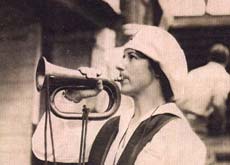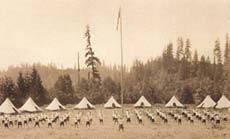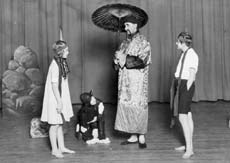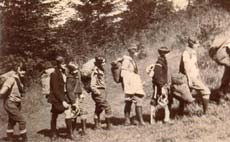 »Introduction
»Introduction
»The 1920s
»Daddy Raker
»The 1930s
»Uncle Toby
»The 1940s
»Elaine Gorham
»The 1950s
»WoHeLo Trees
»The 1960s
»Ginny Denton
»The 1970s
»Land History
»The 1980s
»Camp Directors
»Committee Chairmen
»The 1990s
»Samuel Cobb
»The 2000s
|

|
| The star on the hillside marks the spot where Daddy Raker and Eathel Moore stopped and first viewed
the site, early spring 1924 |
"Mr. Raker was my transportation for my first assignment when I got there. It was
to get a permanent campsite for the Camp Fire Girls. So we worked on that, oh, week after week when I arrived
and Mr. Raker knew the roads - he knew where, probably, we might find something. He took me south and east of
Portland and we landed on that roadway. At the top one tree stood alone way up on the hill on that road that
leads in from the west and goes down into the camp. On the top of that hill on the other side of the river, a
tree stood alone at the side of the road and it looked as if it was a stopping point for anyone who wished to
see the beautiful view. I said, ‘Mr. Raker, let’s pull in under this tree and maybe we can see what we’re
looking for.’ We stopped under that tree sitting in the car and I said, ‘There is our campsite!’ Mr. Raker
said, ‘Do you really think so?’ I said, ‘Absolutely!’
-Eathel Moore Milthaler
W. S. Raker, Chairman of the Camp Committee, consulted a pioneer homesteader named Mr. Lusted and found that
the land belonged to a syndicate headed by Samuel B. Cobb, a Portland lumberman. Cobb had acquired the land
from a pioneer family named Taylor. The syndicate had planned to build a power plant a half mile below the
confluence of the Sandy and Bull Run Rivers. Subsequent surveys showed that the dam would submerge Dodge Park
and Portland’s Bull Run Water Department headquarters, so the idea was abandoned. The land had lain unused for
twenty years when Mr. Raker and Eathel Moore first looked down upon it from the hill across the river.
W. S. Raker made an appointment to meet with Samuel Cobb:

|
| Miss Eathel A. Moore, Exucutive Secretary, blowing an antique French bugle. Camp Fire name: Ohowa Kohassee
Minneyata - Brown Thrasher Singing Beside the Water |
"Some days later we made an appointment and I said to Mr. Raker, ‘You do the talking.’ ‘No,’ he said,
‘I’ll take you there, but you’re going to do the talking.’ So we met Mr. Sam Cobb, the lumberman, and he was
sitting on a high stool at a slanted, sloped drawing board. And he made me think of an historical figure when
we first came in the door - Uriah Heap (a Dickens character). Anyway, in my request, I said he would immortalize
himself to the women of tomorrow if he could give us this acreage for a permanent campsite for the Camp Fire
Girls. And he gave it to us..."
-Eathel Moore Milthaler
Some time later that spring a contingent from the Board of Directors went out to inspect the site. This group
included Mary Thomas, President of the Council, Martha Wedemeyer, Eathel Moore, W. S. Raker and Samuel Cobb.
Also along was Mary Thomas’ daughter, Alice Ann. She recalls that visit:
"We went out on a drive forever until we got out near the junction of the Sandy River and the Bull Run River.
There was a big meadow and a little hill above it. And we went walking across that meadow where we could look
down into one river and then we walked back on the meadow and down to the trail to the other river. Daddy
Raker was talking and Samuel Cobb was talking and they would talk to Martha Wedemeyer and Mary Thomas, and
Daddy Raker said, ‘Lady Thomas, what do you think of this for a camp?’ And the decision was that this
property would be loaned to the Camp Fire Girls to see how it worked out for a year. And the year that it
worked out was 1924."
So Camp Fire began to ready their new camp for the summer, aided by many volunteers and by the Kiwanis Club, a
staunch financial supporter from the beginning. A few traces remained of the original homestead. These included
an apple orchard at the edge of the meadow, a decaying house above the orchard and an old log cabin chicken
coop further up the hill. Part of the old house was salvaged, hot water equipment was installed and the kitchen
was ready. Water was piped from a spring by Martin "Shorty" Luther and Otto G. Muhlig, volunteer plumbers.
Samuel Cobb furnished lumber for a floor built under a tent fly adjacent to the house. This was set up with
tables and benches for a dining area. Fourteen tents were borrowed from the War Department and pitched in the
meadow along with flies for a craft area and infirmary. The Sandy River was sounded for a swimming area and by
early July 1924, Camp Namanu was ready for its first campers.
An Oregonian article announced the beginning of camp:
"A large party of Camp Fire Girls and counselors left Portland Thursday for their summer camp, Namanu, on the
Sandy River near Dodge Park. The campsite was a gift from S. B. Cobb, who has given much time and labor in
getting camp into shape. W. S. Raker and the Camp Committee of the Kiwanis Club have worked hard and expended
much money in putting Camp Namanu in the first rank of girls’ camps in Oregon."

|
| Girls doing their morning upsets before breakfast, 1924 |
Girls that summer were awakened at 7:00 and had "exercises and dip" before breakfast. After eating, there was tent
inspection and morning sing. Two craft sessions were followed by swimming and then dinner at 12:45. After dinner
were both a rest hour and a quiet hour. The late afternoon held more recreation and swimming and then supper
after a formal retreat ceremony. Evenings included games and an evening fire with Taps sounded at 9:30. Thus the
days passed.
There were four weeks of camp held that summer under the able leadership of Miss Eathel Moore. She was assisted by
her father, Professor J. E. Moore of Indianapolis, Indiana, and the camp mother was Mrs. J. Neilson Barry.
The Oregonian describes a day at Namanu:
"On Sunday the girls held services out on the hillside where their songs echoed far over the hills. Many relatives
and friends of the girls were guests at the camp during the day. At night the girls gathered around a blazing
campfire and songs were sung and a biblical pageant of ‘Moses and the Bullrushes’ was given in pantomime, under
the direction of Miss Madeline Rinehart. The girls’ costumes were made from things which they brought to camp
and the play was well presented."
It was a very successful summer, with about 75 girls per session. The season ended with many satisfied campers
looking forward to the next year.
Sadly, during the winter of 1925 Miss Eathel Moore, Executive Director, had to return to Iowa where she was needed
by her family. Miss Gladys Snyder of Lawrence, Kansas, was hired as head counselor as the summer approached. With
only weeks to go before camp opened, Camp Fire was notified by the War Department that their tents could only be
used for military purposes! As often happened, Daddy Raker took charge to solve this problem.
"A meeting of the Camp Committee was called and a council of war was held. We decided that now we had the land,
we should build for permanence, and frame buildings in the long run were decidedly more comfortable and
economical. We proceeded to draw plans for permanent buildings. We took our plans to A. E. Doyle, a firm of
architects, who prepared plans for the main lodge, 40' x 70', to include dining room and kitchen, porches, etc.
and 14 cottages, 12' x 14' for sleeping quarters."
-W. S. Raker
Mr. Raker was able to secure donations of all the lumber and hardware necessary for the structures. Then:
"Since the ground and the material had all been donated, we felt it only fair to give the Labor Temple and
Carpenters Union an opportunity to contribute their share. This they did. The Carpenters Union #226 made a
weekend picnic and barbecue of it, with more than 100 carpenters and their families attending. When they left,
the lodge dining room, kitchen and porches were completed."
-W. S. Raker
As the summer progressed, cabins began to dot Robin Hill across the road from the new lodge, named Raker Lodge
after the Camp Committee Chairman. A director’s cabin, named Glad House for Gladys Snyder, was also built.
Jean Marie Ackerson Spiering recalls the beginning of the summer:
"The following or second year when I came to camp for the first time, the lodge was almost finished. We slept on
the floor in our own wool blankets, which we had learned to fold into an envelope securely fastened with large
blanket pins. During rest hour the men were still working over our heads on the roof. Before long, however, three
cabins were finished on what was to become Robin Hill, and I moved with six other girls and a counselor into the
first one ready. I felt extremely proud to be with older girls! Here in our first cabin were bunks with chicken
wire across the frame, and we put our envelope beds on the mattresses provided.
"At this time the nurse's tent was located in front of the lodge. Mother had her own cot on which to sleep. She
would always be outside her tent when the girls lined up for meals and would greet them and chat with them."
In the fall of 1925, Gladys Snyder was hired as Executive Director of the Portland Council of Camp Fire Girls. She
stayed in that capacity through the summer of 1929 and then she left to pursue further education at Columbia
University in New York City. The Oregonian, in September of 1929, states, "Camp Namanu, the girls’ summer camp,
has been competently built up under Miss Snyder’s supervision and now rates as one of the best camps in the
United States."

|
| Uncle Toby and children acting in "The Mushroom Boy" at the Meier & Frank Auditorium |
Another event in 1925 that was to have a monumental effect on Camp Namanu was the introduction of Theodore Acland
Harper to the Camp Fire program. Harper, a well-known children’s book author of the day, quickly became "Uncle
Toby" to hundreds of campers for years to come.
Jean Marie Ackerson Spiering writes, "Uncle Toby was a gifted story-teller. Many an evening at the campfire or at
story hour in the orchard he enthralled us with his stories of the Skriggleboggle and David & Dawn or of his
meeting Kubrik the Outlaw in Siberia or of strange balls of fire and a white horse in New Zealand. One time
probably after 1924 when Uncle Toby's book, The Mushroom Boy, was printed the Camp Fire Girls gave a little play
based on the story. This was presented in the Meier & Frank Auditorium. I was honored to be the voice of the
Skriggleboggle from backstage."

|
| Volunteers in front of newly completed Kiwanis Lodge |
In 1929, much to the delight of Camp Namanu campers, Kiwanis Lodge was constructed:
"Built to supply the needs of older girls, the senior unit Kiwanis Lodge has two fireplaces, one inside and one
outside, a mezzanine floor and sleeping porch accommodating 25 girls. They conduct their own programs, plan and
cook their own meals, having a fully equipped kitchen, etc. This building is also equipped with toilets, and hot
and cold water for showers. Heat is furnished for the water by coils in the fireplaces. The Portland Kiwanis
Club, who contributed so generously to our campship fund, also provided for part of the material and construction
costs for this building."
-W. S. Raker
Lucy Crossett recalls:
"That was the year that Kiwanis was built, and we Trail Week campers helped. One day during Trail Week we went
back into the woods where a huge cedar tree had been cut down. It had been sawn into pieces the length of
shingles from which some men were shaving shakes and tying them into bundles. We campers formed a line and the
bundles of shakes were passed from one to another until they arrived at the road where Sammy was waiting to
take them up to Kiwanis. The following day we helped nail those shakes on the roof of Kiwanis. To this day I
feel especially privileged to have seen how hand-hewn cedar shakes were made from that large cedar tree in our
Camp Namanu forest. I can still see that clearing in the woods and smell the fragrance of the cedar dust mingled
with the damp earthy smell of the forest floor on which it lay."

|
| Girls leaving on an overnight hike |
A popular activity of this era was taking hikes to explore the hills above camp. The girls would put on their
gypsy bandanas and leave camp singing:
Gypsy, the byways are beckoning,
Through the meadows that glisten with dew,
Into the mist hidden highlands,
Through the forest of fir, pine and yew.
Go forth in the sweet of the dawning,
To follow your truest desire,
And evening will grant you contentment
By the blaze of your caravan fire.
-Marjorie Jones, 1927
Bobbie Smith Drew Forsythe remembers hiking:
"We used to go up from camp, up beyond, and find homesteads of people who had come across Mt. Hood, from the east
and had built houses up there. Most of them were all vacant but there were wonderful apple trees that we enjoyed.
We did find one little old lady up there who was living. We brought her back to camp and she had never seen a
baseball game so we put on a baseball game for her. And she enjoyed it. But she wouldn’t eat with us because she
hadn’t eaten with anyone for so long. She didn’t think her table manners were so very good. So she ate in the
kitchen."
In spite of its icy temperature, swimming in the Sandy was still a very popular activity. The camp report lists
two rowboats, a canoe, a boathouse, a float and a dock as the waterfront facilities at the Camp Namanu swimming
hole.
Gwynn Brice Dockery describes a day at Namanu about this time:
"A regular day in camp started with Reveille, then we all ran down to the meadow for flag raising and morning
exercises. Some hardy souls preceded this with a quick run down to the Sandy River for a ‘dip’ so they could
earn a ‘shivery’ bead. Then came breakfast, followed by camp clean-up, each cabin being assigned a task for the
day, i.e. KP, Suzie Duty, lodge sweeping, etc. Then it was cabin clean-up, with inspection and square corners on
the beds, suitcases open and neat. There was a special honor for the campers with the cleanest cabin for the
session. Each camper selected a couple of activities such as handcrafts, camp crafts, archery or horseback riding.
These were scheduled each day in the morning, and sometimes in the early afternoon - after rest hour which was
the bane of our existence. No whispering, no giggling, no reading - just resting. Each afternoon regular swimming
periods were scheduled - pollywogs, frogs, fish and flying fish - we swam for about a half an hour in the Sandy
River. It was cold, but fun. We also canoed on the river - the present duckpond being only a small swamp. After
dinner, all the campers gathered for the evening fire. Special activities appropriate for the week’s theme were
planned by the cabins and the counselors. And so to bed, with flashlights in hand."
Lucy Crossett recalls:
"In 1928, my first year at camp, there were fourteen cabins on Robin Hill. My cabin was Aquila. I remember the
built-in bunks with chicken wire for springs. At the bottom of Robin Hill were Glad House and Luna, a cabin for
counselors who did not have a cabin to supervise. There were two Suzies, Hill and Lodge. In the meadow was Robin
Hood’s Barn, the Craft House. Service buildings clustered around Raker Lodge were the Ocean, Undine, and the
storage shed, which was a part of the old farm. Uncle Toby loved to tell this story about Jackie Morency and the
old shed: 'They were planning to tear down the shed, but one day Jackie, who was a tiny high school girl and the
camp bugler, leaned up against it and the shed fell down! I believe that was Trail Week of 1929.'"
As the summer of 1929 came to an end, 152 girls had camped at Namanu for one week each, and 213 had attended one
or more two-week sessions. The camp fee was still $7.00 a week and $1.00 for train fare.
"Each session closed with a banquet and the dessert was always Namanu Delight - pineapple and bananas mixed in
sweetened whipped cream. Each session always closed with a Council Fire at which time honors earned during the
week (or two weeks) of camp were given. Highly prized was the Namanu Honor given for outstanding campership. Each
session also had the dream boat ceremony, when each cabin made a floating boat or raft upon which a lighted
candle was placed, and with wishes each cabin launched its boat. A beautiful inspiring event I thought at the
time, and still do."
-Gwynn Brice Dockery

|
| Campers at the Bull Run Station |
The next morning the girls walked out of camp to the Bull Run Power Station and boarded the train for Portland,
singing their way back home. Their voices echoed through the Sandy River Canyon as they crossed the trestle:
I’m dreaming now about the Sandy
And it seems that I can see
The diving board and float,
Sandy beach and boat,
Waiting down the Gypsy Trail for me.
The stately firs send out their fragrance
O’er the trails we love to roam.
I am dreaming of the moonlight on the Sandy
And I long for my Camp Namanu home.
Full-unabridged text of this chapter is available in the 75th Anniversary Book which is for sale at the
Camp Fire USA Portland Metro Council's office in Portland.
©1998 Reprinting only with written permission of Camp Fire USA Portland Metro Council.
|